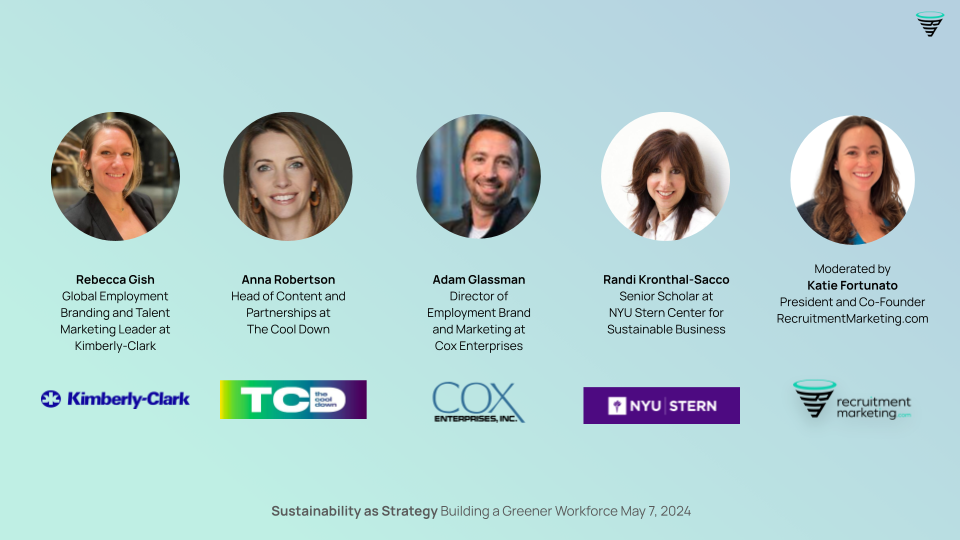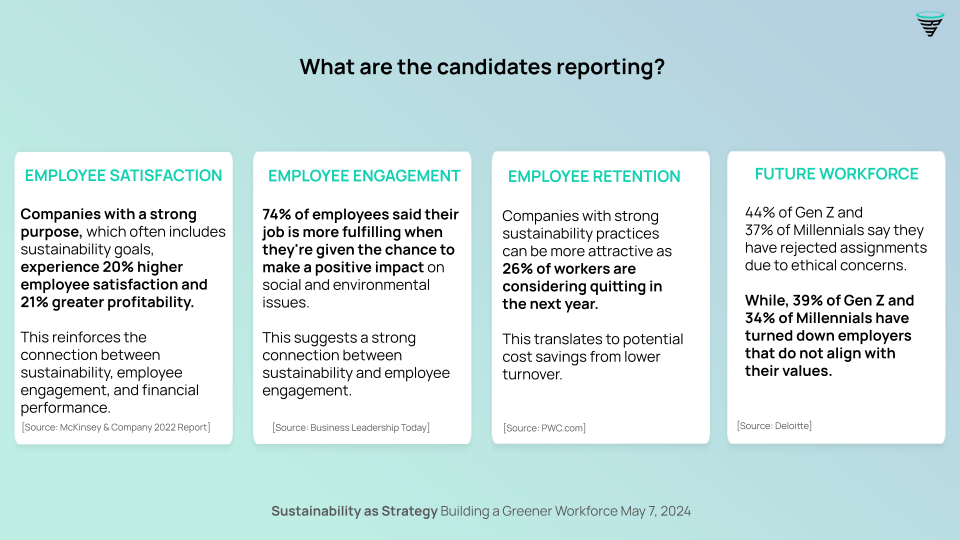Find the right solution for your business.
Explore SolutionsTo get content like our “Sustainability as Strategy” webinar and more delivered to your inbox, subscribe to our newsletter here. It’s free!
Sustainability has transcended buzzword status to become a central pillar of strategic business planning. Our recent Innovation Hiring Lab webinar, ‘Sustainability as Strategy,’ revealed compelling insights into how sustainability is reshaping the job market, influencing corporate governance and redefining employee engagement.
With a lineup of expert speakers and cutting-edge data, we explored the multifaceted impacts of integrating sustainability into business models—not just as a moral imperative but as a pathway to enhanced profitability and competitive advantage.
This article distills the essential takeaways from the discussion, offering a roadmap for businesses ready to harness sustainability as a transformative force in their operations.
Our Panelists:
- Rebecca Gish, Global Employment Branding and Talent Marketing Leader at Kimberly-Clark
- Anna Robertson, Head of Content & Partnerships at The Cool Down
- Adam Glassman, Director of Employment Brand and Marketing at Cox Enterprises
- Randi Kronthal-Sacco, Senior Scholar at NYU Stern Center for Sustainable Business
- Katie Fortunato, President & Co-Founder of RecruitmentMarketing.com (moderator)

Job Market and Sustainability
The job market is seeing a significant rise in both job openings and candidates with sustainability skills. Since 2018, the demand for climate-related roles has tripled, with ESG (Environmental, Social and Governance) and CSR (Corporate Social Responsibility) positions offering higher pay compared to other roles.
In March, the U.S. Securities and Exchange Commission (SEC) finalized new regulations requiring public companies to disclose their climate-related impact in annual reporting. According to Deloitte, senior management will need to navigate the potential impacts on their business, describe their companies’ greenhouse gas emissions, assess climate risks and establish governance procedures around their sustainability practices.
Companies must adapt to these changes to remain competitive in attracting top talent and meeting regulatory requirements. The Deloitte website provides further information on the SEC regulations and how businesses can effectively respond to these new challenges.
Candidate and Employee Perspectives on Sustainability
Two recent polls highlight the growing importance of sustainability in the workplace. The Cool Down poll found that nearly 50% of respondents would not work for a company without a sustainability strategy or would only do so if the pay was good, indicating that a significant portion of the workforce prioritizes sustainability.
Similarly, a RecruitmentMarketing.com poll revealed that 34% of respondents were unsure if their employer took sustainability efforts seriously.
During the webinar, Katie presented a series of statistics demonstrating the impact of sustainability on employee satisfaction, engagement, retention, and the future workforce:

These findings underscore the growing significance of sustainability in attracting and retaining talent, particularly among younger generations. Companies that prioritize sustainability are more likely to have satisfied, engaged, and committed employees, leading to improved business outcomes.
Starting and Implementing Sustainable Practices
For companies looking to start or implement sustainable practices, the CEO and C-suite must be actively involved in discussing and promoting sustainability throughout the organization.
However, you may face several challenges when implementing sustainable practices. These include legacy thinking that consumers won’t buy sustainable products, concerns about greenwashing, and a lack of skills and knowledge to effectively communicate sustainability efforts.
To overcome these challenges, you should take an authentic approach and avoid disingenuous messaging. As Rebecca from Kimberly-Clark states, “I always like to use the phrase with my team show, don’t tell, show someone how sustainability comes to life at Kimberly-Clark. Don’t just tell them we have sustainable practices. So that, and that helps it to be real authentic.”
Embedding Sustainability into Company Culture
Embedding sustainability into company culture requires a commitment to authenticity and transparency. Companies must not only talk about their sustainability efforts but also follow through with concrete actions.
As Anna from The Cool Down points out, “Employees, customers can sniff it out when it’s not real. And I think it’s such an important point because it’s one thing to create an employment engagement sustainability strategy within your company, but it’s another to really listen to employees when they have ideas—when they bring things forward and actually follow through with them.”
Empowering employees to identify and elevate solutions is a key aspect of creating a sustainable culture. You can foster a sense of ownership and engagement by involving employees in the process. This will lead to more innovative and effective solutions.
It’s essential to make sustainability a company-wide concern, rather than relegating it to a single department.
As Adam from Cox Enterprises states, “Sustainability gives you one of those points of influence where you can influence that sentiment so that somebody ends up loving that brand. They choose that brand. They frequent that brand down the road—they may not even be able to put their finger on why they love the brand. Sustainability and what the company is doing in that area becomes a source of influence in that brand love.”
The Recruitment Advantage of Sustainability
Sustainability has become a significant factor in attracting top talent, particularly among younger generations.
To effectively leverage sustainability as a recruitment advantage, focus on linking sustainability to social issues and highlighting individual employee stories. You can create compelling narratives that resonate with job seekers just by showcasing how sustainability comes to life within the organization, and how employees contribute to these efforts.
Track engagement, conversion rates and drop-offs in the hiring process when measuring the impact of sustainability on recruitment. By analyzing these metrics, you can gain insights into how your sustainability messaging is resonating with candidates. These will help make data-driven decisions to optimize your recruitment strategies.
Ultimately, companies that successfully integrate sustainability into their employer branding and recruitment efforts will be better positioned to attract and retain the best talent in an increasingly competitive job market.
Crafting Authentic and Effective Sustainability Messages
To craft authentic and effective sustainability messages, consider the factors that resonate with your target audience. According to Randi from NYU Stern Center for Sustainable Business, the three areas that resonated the most with consumers and had no polarization across the political spectrum, age or gender were:
- Health: Highlighting the absence of toxic ingredients or the presence of health-improving attributes.
- Wealth: Emphasizing cost savings or durability of products.
- Personal world: Focusing on the impact on consumers’ children, the future, local farmers, or sustainable local sourcing.
Additionally, younger users are particularly interested in the science behind sustainability. Incorporating scientific information and data can help establish credibility and appeal to this demographic.
Another important aspect of crafting effective sustainability messages is localizing storytelling for different talent pools. As Rebecca explained, “So how we level up for my team is looking at how we really get to those local stories, because we support across the globe. And people want to know how you’re making a difference in their community—how you’re making an impact in sustainability right here in my world—not for the globe, even though that’s important.”
Building the Business Case for Sustainability
Building a strong business case for sustainability is crucial for companies to invest in and prioritize sustainable practices. Research has consistently shown that sustainability drives revenue and positively impacts bottom-line performance. In fact, according to Randi, “Banks loan at lower interest rates for good actors. The business case is there and anybody who doesn’t see it is really not necessarily looking at the data.”
Sustainability can also provide a significant competitive advantage for companies. Those that successfully incorporate sustainability into their business practices are more likely to attract and retain top talent, appeal to environmentally-conscious consumers, and build a positive brand reputation.
To build a compelling business case for sustainability, companies should:
- Examine research and data that demonstrate the financial benefits of sustainable practices.
- Identify potential cost savings and revenue opportunities associated with sustainability initiatives.
- Assess the competitive landscape and benchmark against industry leaders in sustainability.
- Evaluate the risks of not adopting sustainable practices, including the potential loss of market share and talent.
Present a data-driven business case that highlights the financial, competitive, and reputational advantages of sustainability. You should be able to secure buy-in from stakeholders and leadership to invest in and prioritize sustainable practices.
Resources
- The Cool Down newsletter signup
- NYU Stern Center for Sustainable Business & Edelman Research Report, Effective Sustainability Communications: A Best Practice Guide for Brands & Marketers
- Cox Enterprise Sustainability Operations
- Kimberly-Clark’s Investor Day 2024
Conclusion and Key Takeaways
The webinar highlighted the growing importance of sustainability in the business world and its impact on talent acquisition and retention. As companies navigate the challenges of incorporating sustainable practices, talent acquisition and people leaders play a crucial role in driving these initiatives forward.
Key takeaways and advice for these leaders include:
- Engage employees and empower them to contribute to sustainability efforts. Encourage participation in green teams, volunteer opportunities, and idea generation to foster a sense of ownership and commitment to sustainability within the organization.
- Incorporate sustainability into benefits and total rewards. Consider offering benefits such as volunteer time off, matching donations for sustainable causes, or partnerships with eco-friendly vendors. This demonstrates the company’s commitment to sustainability and attracts like-minded talent.
- Continuously educate oneself on sustainability. Stay informed about the latest trends, best practices and industry developments. You can attend workshops, reading relevant publications and engaging with sustainability experts.
- Collaborate with sustainability teams within the organization. Establish regular communication and collaboration with internal sustainability teams to align talent acquisition strategies with the company’s overall sustainability goals and initiatives.
- Take action, even if starting small. Do what you can with what you’ve got. Every step towards sustainability, no matter how small, contributes to the larger goal and helps build momentum for more significant changes.
By implementing these strategies and leading by example, you can play a vital role in building sustainable organizations that attract and retain top talent while positively impacting the environment and society.

